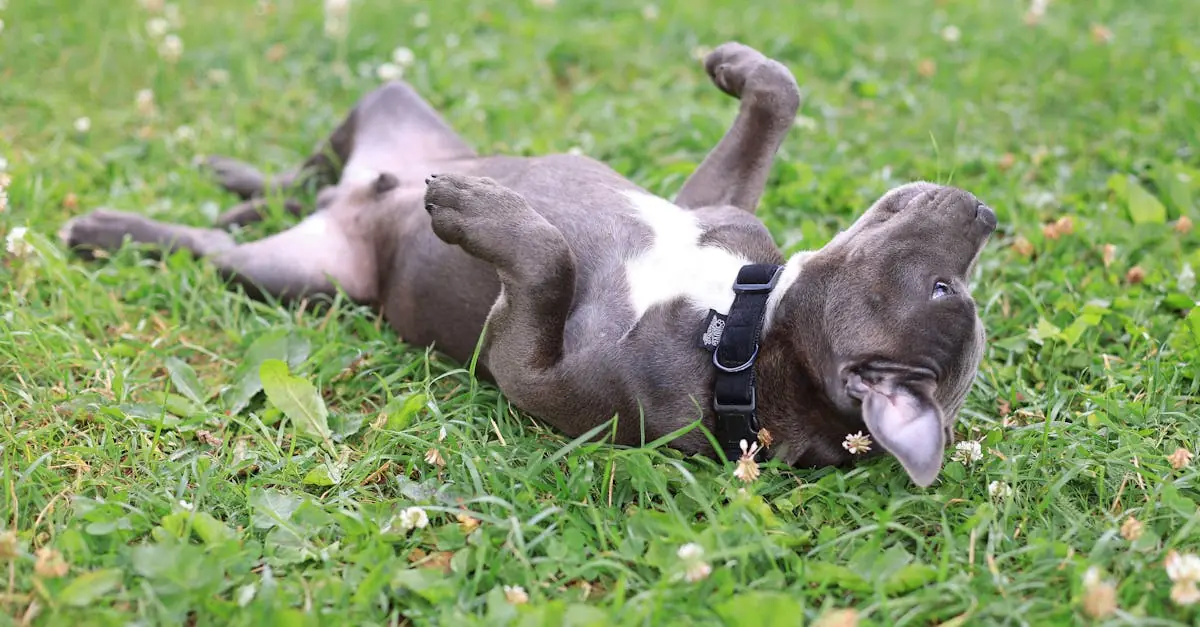Bringing a puppy home is like welcoming a tiny tornado of fur and mischief. Those adorable little faces can turn even the most patient pet owner into a frazzled mess when they chew shoes or leave surprise gifts on the carpet. But don’t worry—it’s not all chaos and confusion! With the right approach to discipline, you can guide your furry friend toward better behavior without losing your sense of humor.
Table of Contents
ToggleUnderstanding Puppy Behavior
Understanding puppy behavior is key to managing their actions. Puppies exhibit a variety of behaviors that require attention.
Common Bad Behaviors
Chewing furniture, barking excessively, and biting are prevalent issues. Puppies often dig holes in gardens and jump on people, which can be problematic. Accidents in the house add to the difficulties for new pet owners. They might steal food from counters or scratch doors when anxious. Each instance of misbehavior can disrupt harmony in the home.
Causes of Misbehavior
Lack of training often leads to undesirable actions. Puppies might act out due to boredom or excess energy needing an outlet. Socialization plays a role; insufficient exposure to environments can cause anxiety. Inconsistent discipline contributes to confusion about acceptable behavior. Additionally, transitions and changes in routine can affect a puppy’s actions significantly.
Positive Reinforcement Techniques
Positive reinforcement effectively encourages desired behaviors in puppies. These techniques focus on rewarding good behavior rather than punishing missteps.
Reward-Based Training
Reward-based training relies on positive stimuli to help puppies learn. Treats often work well; offering a small piece of kibble or a favorite snack reinforces good actions. Praise also plays a crucial role; verbal affirmations like “good dog” accompany physical affection, strengthening the bond. Consistency in rewards helps puppies understand what behaviors yield positive outcomes. Timing is essential; giving the reward immediately after a desired action increases the likelihood of repetition. Training sessions should remain short, about 5 to 10 minutes, to maintain engagement and prevent distraction.
Encouraging Good Behavior
Encouraging good behavior involves redirecting unwanted actions. When a puppy engages in inappropriate activities, guiding them toward acceptable alternatives proves beneficial. Providing chew toys can prevent furniture destruction, while encouraging play with appropriate items lessens the chances of unwanted chewing. Setting a structured routine fosters predictability, making it easier for the puppy to understand expectations. Monitoring interactions helps identify triggers that lead to bad behavior. By consistently rewarding good behavior, pet owners reinforce the notion that positive actions lead to rewarding experiences.
Correcting Bad Behavior
Correcting bad behavior in puppies involves clear strategies that align with their learning processes. Implementing effective techniques leads to an easier training journey.
Redirecting Attention
Redirecting attention proves useful for managing unwanted behaviors. When a puppy starts chewing on furniture, offering a chew toy captures its interest. Redirecting also applies during excessive barking; engaging with a command such as “sit” shifts focus. Providing toys encourages play and distracts from digging or jumping. Consistent redirection with suitable alternatives helps puppies understand what behaviors are acceptable. Using this approach establishes a productive training environment.
Time-Out Method
Implementing the time-out method assists in addressing persistent bad behavior. When a puppy becomes overly excited or starts biting, a brief time-out becomes beneficial. Isolating the puppy in a safe area for a few minutes allows it to calm down. This method helps puppies associate misbehavior with the loss of playtime or interaction. Remaining firm yet gentle during time-outs fosters understanding without promoting anxiety. By using time-outs consistently, pet owners set clear boundaries and encourage better choices in their puppies’ behavior.
Alternative Disciplinary Methods
Alternative methods for disciplining puppies emphasize positive interactions. These techniques not only curtail bad behavior but also reinforce the bond between pet and owner.
Using Commands Effectively
Establish clear commands for effective communication. Training puppies with consistent cues like “sit,” “stay,” and “leave it” builds structure in their behavior. Owners must use a firm but gentle tone to convey authority. Utilizing hand signals alongside verbal commands enhances understanding. Puppies respond well to clarity and repetition, making it essential to practice commands in various settings. When a puppy follows a command, immediate praise or treats reinforce the positive behavior. This approach supports learning while reducing undesired actions. Regular practice ensures puppies embrace commands, contributing to their overall training success.
Behavioral Cues and Signals
Recognizing a puppy’s behavioral cues and signals aids in discipline. Body language often indicates discomfort or excitement, affecting behavior. For instance, wagging tails or lowered ears can signal specific emotions. Observing these cues allows owners to anticipate actions before they escalate. If a puppy starts barking or digging, intervening promptly can redirect their focus. Using a calm voice and redirecting attention to a toy or command can help. Encouraging appropriate behavior through understanding fosters a supportive learning environment. Regularly engaging with a puppy’s needs enhances communication and reduces misunderstandings, leading to improved behavior over time.
When to Seek Professional Help
Recognizing when a puppy requires professional assistance is vital. Some behaviors signal the need for expert intervention.
Signs Your Puppy Needs Assistance
Persistent aggression towards people or other pets can indicate underlying issues. Frequent anxiety when left alone may lead to destructive behaviors. Lack of progress despite consistent training efforts signifies the need for help. Uncontrollable barking or digging can disrupt household serenity, pointing to behavioral challenges. Additionally, repeated accidents indoors suggest difficulties with potty training. Any significant changes in your puppy’s eating or sleeping patterns may also warrant a professional’s guidance.
Finding a Qualified Trainer
First, look for trainers with certification from reputable organizations, such as the Association of Professional Dog Trainers. Trainers experienced in positive reinforcement techniques will align with best practices for puppy training. Ask for recommendations from friends or veterinarians to find trusted professionals. Review online testimonials and check for success stories to understand a trainer’s approach. Attend an initial session to gauge compatibility with your puppy’s personality and needs. Consider group classes for socialization opportunities, which can facilitate both learning and interaction.
Disciplining a puppy for bad behavior requires patience and understanding. By implementing positive reinforcement techniques and maintaining consistency, pet owners can guide their puppies toward better choices. It’s crucial to redirect unwanted behaviors and provide clear commands to establish boundaries effectively.
Engaging with a puppy’s needs and recognizing their signals fosters a supportive learning environment. When challenges arise, seeking professional help can provide valuable insights and strategies tailored to specific issues. With dedication and the right approach, pet owners can nurture their puppies into well-behaved companions, enhancing the bond they share.






